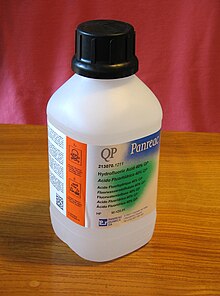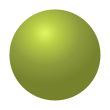
Back حمض الهيدروفلوريك Arabic Ácidu fluorhídricu AST هیدروفلوئوریک اسید AZB Фторыставадародная кіслата Byelorussian Флуороводородна киселина Bulgarian Fluoridna kiselina BS Àcid fluorhídric Catalan Kyselina fluorovodíková Czech Плавик йӳçекĕ CV Flussyre Danish
| |||
| |||

| |||
| Names | |||
|---|---|---|---|
| IUPAC name
Fluorane[1]
| |||
| Other names
Fluorhydric acid
Hydronium fluoride | |||
| Identifiers | |||
3D model (JSmol)
|
|||
| ChEBI | |||
| ChemSpider | |||
| EC Number |
| ||
PubChem CID
|
|||
| RTECS number |
| ||
| UNII | |||
CompTox Dashboard (EPA)
|
|||
| |||
| |||
| Properties | |||
| HF (aq) | |||
| Appearance | Colorless liquid | ||
| Density | 1.15 g/mL (for 48% soln.) | ||
| Acidity (pKa) | 3.17[2] | ||
| Hazards[3] | |||
| GHS labelling: | |||
 
| |||
| Danger | |||
| H280, H300+H310+H330, H314 | |||
| P260, P262, P264, P270, P271, P280, P284, P301+P310, P301+P330+P331, P302+P350, P303+P361+P353, P304+P340, P305+P351+P338, P310, P320, P321, P322, P330, P361, P363, P403+P233, P405, P410+P403, P501 | |||
| NFPA 704 (fire diamond) | |||
Except where otherwise noted, data are given for materials in their standard state (at 25 °C [77 °F], 100 kPa).
| |||
Hydrofluoric acid is a solution of hydrogen fluoride (HF) in water. Solutions of HF are colorless, acidic and highly corrosive. A common concentration is 49% (48-52%) but there are also stronger solutions (e.g. 70%) and pure HF has a boiling point near room temperature. It is used to make most fluorine-containing compounds; examples include the commonly used pharmaceutical antidepressant medication fluoxetine (Prozac) and the material PTFE (Teflon). Elemental fluorine is produced from it. It is commonly used to etch glass and silicon wafers.
- ^ Favre, Henri A.; Powell, Warren H., eds. (2014). Nomenclature of Organic Chemistry: IUPAC Recommendations and Preferred Names 2013. Cambridge: The Royal Society of Chemistry. p. 131. ISBN 9781849733069.
- ^ Harris, Daniel C. (2010). Quantitative Chemical Analysis (8th international ed.). New York: W. H. Freeman. pp. AP14. ISBN 978-1429263092.
- ^ "Hydrofluoric Acid". PubChem. National Institute of Health. Retrieved October 12, 2017.
© MMXXIII Rich X Search. We shall prevail. All rights reserved. Rich X Search




